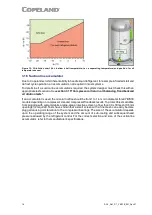
12
AGL_Ref_ST_YBK1E_EN_Rev01
Electrical connection
▪
Connect the crankcase heater according to the compressor application guidelines.
▪
The crankcase heater must be connected only to its rated voltage.
▪
The metal braid of the heater must be connected to a suitable earthing terminal.
▪
Check the resistance according to the technical data.
▪
Perf orm an insulation test before start-up.
▪
Electrical security and safety measures are to be provided on site.
3.7
Discharge gas temperature protection
CAUTION
Inadequate lubrication! Scroll set damage!
All YB*K1E compressors must
be equipped with a discharge gas temperature protection.
A good system control shall prevent the system f rom operating outside the published operating
envelope and acceptable superheat range, whatever the climatic conditions and the cap acity
demand. However, under some extreme operating conditions such as loss of charge or improper
control operation, the internal discharge gas temperature reached can cause compressor damage.
In order to ensure positive compressor protection, discharge gas temperature protection is required
f or any application with Copeland brand compressors.
The maximum discharge gas temperature is 130 °C f or YB*K1E compressors.
Discharge gas temperature protection is the "fall-back" for failure of the system control. It is essential
that proper control of both the evaporating and condensing pressures and the superheat is
maintained and has the ability to cope with all likely conditions and high loads. Reliance on protectors
will cause inadequate system performance and short cycling.
NOTE: The maximum discharge gas temperatures indicated in this chapter are valid for safe
operation within the approved application envelope. The discharge line thermostat has the
function of a compressor protection device; it is not designed to control the operating
envelope. For compressor envelope control, an additional control device or regulation must
be used.
3.7.1 Excessive discharge gas temperatures
A f ew of the possible consequences of excessive discharge gas temperatures are listed below:
▪
Since the oil circulates in the system with the ref rigerant, it is subjected to high discharge gas
temperatures. If the discharge gas temperature becomes too high, the so-called "cooking" effect
will occur (heating of oil under exclusion of air). Carbon deposits can f orm at points of high
temperature, for example on the valves, oil channels, oil filters, etc. The oil lubricity will be reduced
and a progressive wear process will occur which will prematurely damage the compressor.
▪
The stability of the ref rigerant can also be af f ected, particularly if traces of contaminant are
present.
The problems described above f requently occur simultaneously, particularly since the chemical
reaction speed approximately doubles with every 10 °C temperature rise. This directl y leads to
chemical reactions of the oil with the ref rigerant and the compounds extracted f rom sealants and
insulation material. As a consequence, contaminants of various types, among them acids, will form
inside the system.
3.7.2 Discharge line thermostat
YB*K1E compressors have no internal discharge gas temperature protection. Therefore, an external
discharge line thermostat must be installed.
Figure 10: Discharge line thermostat with clamp
















































